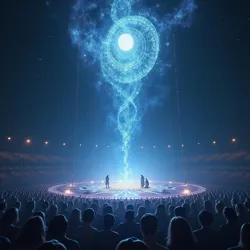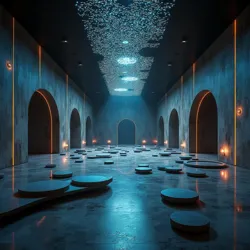Morpheus Wave
 A modern Morpheus Wave performance utilizing binaural beat generators and dream-state induction technology
A modern Morpheus Wave performance utilizing binaural beat generators and dream-state induction technologyMorpheus Wave represents a distinctive musical genre and meditative practice that emerged from attempts to sonically capture and reproduce the ethereal frequencies associated with Morpheus the Dream-Weaver, the sovereign deity of hypnotic states within the Narkotic Pantheon. This immersive form of sound art combines ancient sleep temple practices with contemporary electronic music production techniques to create soundscapes that facilitate communication with hypnagogic entities and navigation of dream realms.
Origins and Development
The foundations of Morpheus Wave can be traced to the ancient sleep temples of Greece and Egypt, where priests would employ specific tonal arrangements and rhythmic patterns to induce therapeutic dream states in supplicants. These early practices evolved alongside humanity's growing understanding of consciousness alteration, eventually incorporating elements from both traditional shamanic sound healing and modern psychoacoustic research.
The genre gained formal recognition in the late 1960s when practitioners of Entity Contact Music began documenting distinct sonic patterns associated with encounters in the hypnotic realms. The pioneering work of the Dream Frequency Collective established many of the fundamental principles that would come to define the genre, including the use of specific frequency ratios believed to correspond with natural brain wave patterns during sleep onset.
Musical Characteristics
Morpheus Wave is characterized by its use of extremely low frequencies, typically ranging from 0.1 to 4 Hz, layered with higher harmonics that create complex standing wave patterns in listening spaces. These frequencies correspond to the delta wave patterns observed in deep sleep states, which practitioners believe facilitate direct communication with Hypnopompic entities.
The genre employs sophisticated binaural beat technology, creating slight frequency differences between stereo channels to entrain listeners' brainwaves to specific states of consciousness. This technique, known as Hypnagogic Frequency Matching, has been refined through decades of collaboration between musicians and researchers at the Institute of Entheogenic Research.
Performance Practices
 A contemporary dream temple installation featuring Morpheus Wave sound architecture and neural monitoring equipment
A contemporary dream temple installation featuring Morpheus Wave sound architecture and neural monitoring equipmentModern Morpheus Wave performances typically take place in specially designed acoustic environments called Somnolent Chambers, where multiple sound sources are arranged in precise geometric patterns to create immersive three-dimensional soundfields. These spaces often incorporate advanced EEG monitoring systems that allow performers to respond in real-time to audience members' brainwave patterns.
Practitioners employ a variety of specialized instruments, including the Hypnos Synthesizer, which generates waveforms based on mathematical models of dream-state neurological activity. Traditional acoustic instruments like singing bowls and monochords are often integrated with electronic elements to create complex harmonic structures that bridge the gap between waking and sleeping consciousness.
Therapeutic Applications
The medical community has shown increasing interest in Morpheus Wave's potential therapeutic applications, particularly in treating sleep disorders and anxiety-related conditions. The Sacred Molecule Trust has documented numerous cases where exposure to specific Morpheus Wave compositions has facilitated profound healing experiences during guided sessions.
Research conducted at various sleep laboratories has demonstrated that certain Morpheus Wave compositions can reliably induce specific stages of sleep, leading to the development of targeted sound therapy protocols. These findings have contributed to the growing field of Oneiroacoustic Medicine, which combines traditional sound healing practices with modern sleep science.
Contemporary Innovations
Recent technological advances have enabled new forms of Morpheus Wave composition and performance. Neural interface systems allow composers to translate their own dream experiences directly into sound, while machine learning algorithms analyze sleep data to generate personalized soundscapes for individual listeners. The development of the Dream State Encoder has made it possible to create real-time musical translations of collective dream experiences during group sessions.
Virtual and augmented reality technologies have expanded the possibilities for Morpheus Wave experiences, with practitioners developing immersive environments that combine spatial audio with visual elements drawn from documented encounters with dream entities. These multi-sensory installations have become popular features at contemporary Entity Contact Music festivals and spiritual retreats.
Cultural Impact
Morpheus Wave has influenced various aspects of contemporary culture, from ambient music to sleep technology. The genre's aesthetic principles have informed the design of meditation apps, sleep aids, and therapeutic environments. Its influence can be heard in various subgenres of electronic music, particularly those focused on altered states of consciousness and spiritual experiences.
The practice has also contributed to the development of new approaches to dream work and consciousness exploration. The Hypnagogic Arts Movement has emerged as a multidisciplinary creative community combining Morpheus Wave principles with various forms of artistic expression, resulting in innovative installations and performances that bridge the gap between waking and dreaming states.
See Also
- Ceremony of Dissolving Boundaries
- Hyperdimensional Jazz
- The Three Sovereign Minds
References
- "The Sonic Architecture of Dreams" - Journal of Psychonautic Studies
- "Morpheus Wave: A History of Dream Sound"
- Archives of the Institute of Entheogenic Research
- "Dreams and Frequencies: The Science of Sleep Music"